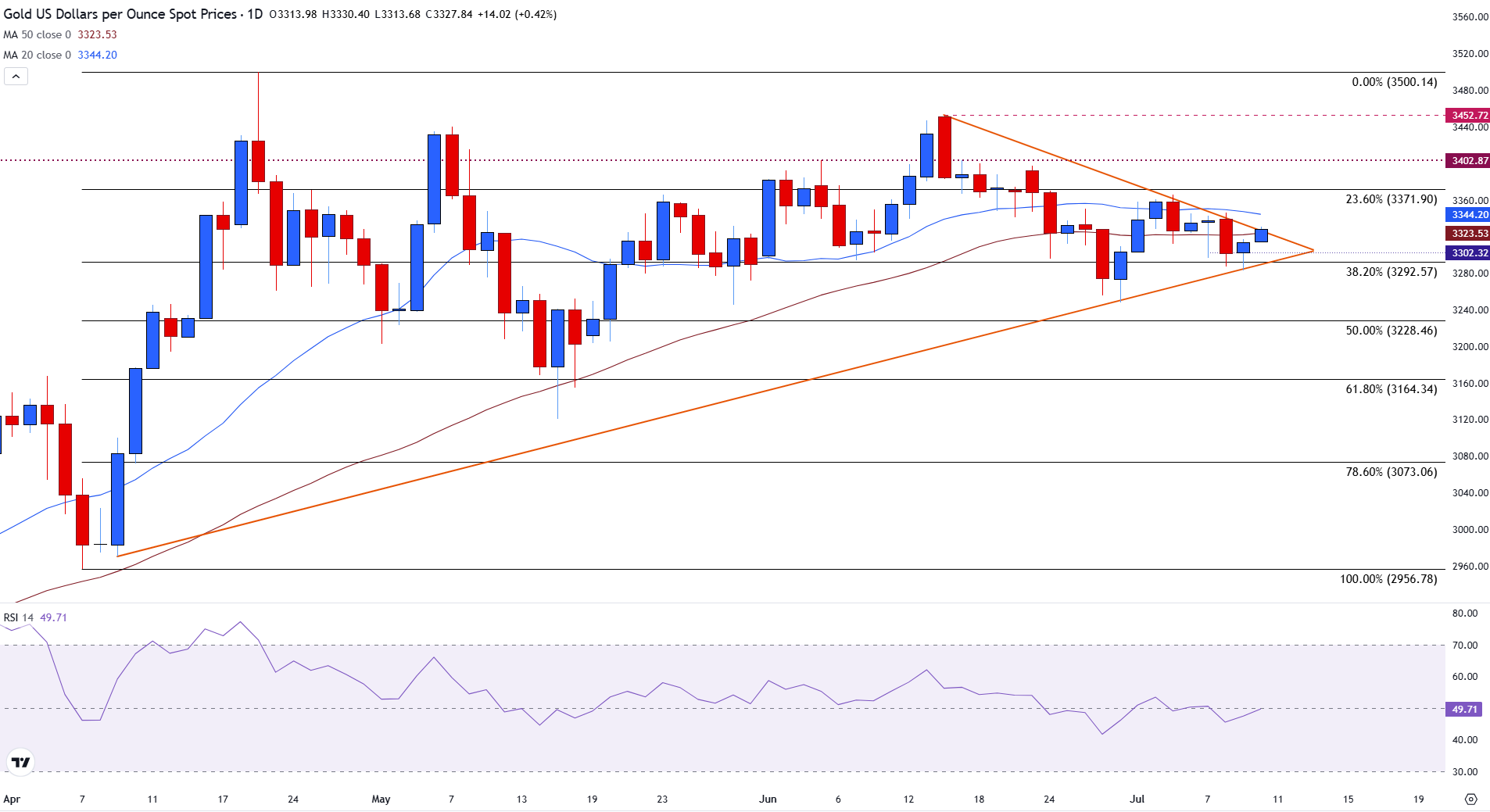Gold rises for second consecutive day as trade tensions intensify
- Gold price rises as demand for safe havens recovers amid additional tariff threats from Donald Trump.
- Jobless Claims and Fed speakers are at the top of the US economic agenda as investors monitor the health of the US labour market.
- XAU/USD flirts with moving average resistance as the price tests the upper bound of a symmetrical triangle pattern.
Gold (XAU/USD) is ticking up slightly on Thursday, benefiting from escalating global trade tensions as recent tariff announcements from US President Trump have rekindled investors' appetite for bullion as a traditional safe-haven asset.
At the time of writing, XAU/USD is trading near $3,325, with persistent tariff threats – the latest targets were Brazil and Copper products – underpinning the Gold price in the short term.
Traders look ahead to the next fundamental catalyst, US Jobless Claims data, scheduled for release at 12:30 GMT. This report, published by the US Department of Labor, measures the number of individuals filing new and continuing claims for state unemployment benefits and can provide insights about the health of the US labor market.
Initial Jobless Claims are expected at 235,000, up slightly from 233,000 a week earlier, and Continuing Claims at 1.98 million. These figures are important labor market indicators given the Federal Reserve's data-dependent policy. Remarks from Fed officials Alberto Musalem, Christopher Waller, and Mary C. Daly will be scrutinized for potential policy signals later today.
Daily Digest Market Movers: Gold climbs as Trump's tariffs trigger fresh safe-haven demand
- The minutes from the latest Federal Reserve policy meeting, released Wednesday, highlighted officials' concerns over persistent inflation risks stemming from tariffs. The minutes noted that "most participants noted the risk that tariffs could have more persistent effects on inflation," underscoring a cautious stance with a preference for clarity on economic outlook.
- Markets are currently assigning a 67.4% chance to a 25-basis-point interest rate cut by September, according to the CME FedWatch Tool. This year, the Fed has consistently held interest rates within a 4.25% to 4.50% range, supported by a resilient US labour market.
- Trade tensions have intensified after President Trump announced a significant 50% tariff on Copper imports, effective August 1, citing national security concerns. Trump declared via Truth Social, "America will, once again, build a DOMINANT Copper Industry." Brazil also faced fresh tariffs amid Trump's assertion that ongoing political proceedings against former Brazilian President Jair Bolsonaro are politically motivated. Further, Trump initiated a Section 301 investigation targeting Brazil’s digital trade policies.
- At a recent Cabinet meeting on Tuesday, Trump reinforced the firmness of the August 1 tariff implementation deadline, insisting, “Everybody has to pay. And the incentive is that they have the right to deal in the United States.” Additionally, Trump publicly criticized Fed Chair Jerome Powell, demanding his resignation via Truth Social and accusing him of politically motivated monetary policy: "Rates should have been cut months ago. The only reason they’re not is because Powell doesn’t want me to win.”
- Throughout the week, the US administration dispatched tariff-related letters to roughly 20 countries, including Japan and South Korea, outlining the fresh tariff rate.
Gold technical analysis: XAU/USD regains confidence above $3,300

Gold (XAU/USD) Daily chart.
From a technical standpoint, Gold is testing the upper edge of a symmetrical triangle pattern, with the 20-day Simple Moving Average (SMA) currently providing resistance at $3,344.
At the time of writing, XAU/USD is hovering above the 50-day Simple Moving Average (SMA) at $3,323.
Key support lies at the psychological $3,300 mark and the 38.2% Fibonacci retracement level of April’s rally at $3,292. Additionally, the Relative Strength Index (RSI) hovering near neutral at 49 indicates indecision in the market. Meanwhile, immediate resistance is seen at the 20-day SMA of $3,344.
A decisive move below the crucial $3,300 level could open the door to additional downside pressure, targeting the 50% Fibonacci retracement zone and potentially further technical selling.
Gold FAQs
Gold has played a key role in human’s history as it has been widely used as a store of value and medium of exchange. Currently, apart from its shine and usage for jewelry, the precious metal is widely seen as a safe-haven asset, meaning that it is considered a good investment during turbulent times. Gold is also widely seen as a hedge against inflation and against depreciating currencies as it doesn’t rely on any specific issuer or government.
Central banks are the biggest Gold holders. In their aim to support their currencies in turbulent times, central banks tend to diversify their reserves and buy Gold to improve the perceived strength of the economy and the currency. High Gold reserves can be a source of trust for a country’s solvency. Central banks added 1,136 tonnes of Gold worth around $70 billion to their reserves in 2022, according to data from the World Gold Council. This is the highest yearly purchase since records began. Central banks from emerging economies such as China, India and Turkey are quickly increasing their Gold reserves.
Gold has an inverse correlation with the US Dollar and US Treasuries, which are both major reserve and safe-haven assets. When the Dollar depreciates, Gold tends to rise, enabling investors and central banks to diversify their assets in turbulent times. Gold is also inversely correlated with risk assets. A rally in the stock market tends to weaken Gold price, while sell-offs in riskier markets tend to favor the precious metal.
The price can move due to a wide range of factors. Geopolitical instability or fears of a deep recession can quickly make Gold price escalate due to its safe-haven status. As a yield-less asset, Gold tends to rise with lower interest rates, while higher cost of money usually weighs down on the yellow metal. Still, most moves depend on how the US Dollar (USD) behaves as the asset is priced in dollars (XAU/USD). A strong Dollar tends to keep the price of Gold controlled, whereas a weaker Dollar is likely to push Gold prices up.

